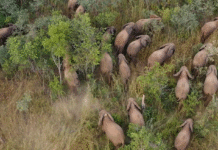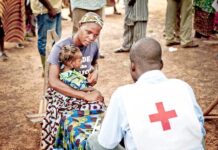Illustrative Image: The State of Neuroscience in East Africa: Challenges, Innovations, and Future Opportunities for Strengthening Research and Healthcare Capacity
Image Source & Credit: aiforgood
Ownership and Usage Policy
A recent study by Nageyle et al. (2025) titled “The status of neuroscience in East Africa: A narrative review” published in the East African Journal of Neurological Sciences reveals that East Africa faces a major yet underdiagnosed burden of neurological disorders, but growing innovation, collaboration, and education efforts offer hope for strengthening neuroscience capacity in the region.
“
East Africa faces a major neurological disease burden, but growing innovation, education, and collaboration offer hope for strengthening neuroscience capacity.
– Nageyle et al. 2025
The study provides an in-depth analysis of the current landscape of neuroscience across East African nations, exploring their achievements, persistent challenges, and future opportunities. The review assesses the state of neuroscience in East Africa, focusing on the prevalence of neurological disorders, the status of education and training, research infrastructure, technological advancements, and collaborative initiatives. It seeks to identify barriers hindering progress and propose strategic solutions to strengthen neuroscience research, education, and healthcare delivery in the region. Neurological disorders such as epilepsy, stroke, dementia, and neuroinfections (including HIV, tuberculosis, and cerebral malaria) represent a significant public health burden across East Africa. However, diagnosis and treatment are often delayed due to outdated technology, inadequate diagnostic tools, and limited access to specialized care. In the area of education and training, progress is evident through the establishment of new residency and fellowship programs—particularly in Ethiopia and Kenya—but major gaps persist. There remains a shortage of trained neuroscientists and clinicians, fragmented curricula, and few postgraduate opportunities in neuroscience. Moreover, the brain drain phenomenon continues to deprive the region of skilled professionals who migrate for better career prospects abroad.
When it comes to research infrastructure, the review highlights chronic underfunding and an overreliance on international collaborators and institutions. Only a small proportion of neuroscience research in East Africa is locally financed, and the region trails behind other parts of Africa, such as South Africa and Egypt, in terms of research productivity and innovation. Despite these challenges, technological advancements are gradually transforming the field. The adoption of CT scans, MRI, and telemedicine has improved diagnosis and treatment options, while a growing interest in using indigenous animal models for neuropharmacological and genetic studies marks an important step toward contextually relevant research. Collaborations have also played a pivotal role in building capacity and awareness. Regional and global partnerships—such as those led by PAANS (Pan African Association of Neurological Sciences), SONA (Society of Neuroscientists of Africa), and WFNS (World Federation of Neurosurgical Societies)—have strengthened training, mentorship, and knowledge exchange. Initiatives like Brain Awareness Week and inter-university programs are helping to foster regional solidarity and public engagement in neuroscience.
How the Study was Conducted
The study employed a narrative review approach, meaning the authors synthesized existing literature and data rather than conducting new experiments or collecting original data. To achieve this, they systematically searched multiple electronic databases—PubMed, Google Scholar, and Scopus—using a comprehensive search strategy that incorporated Medical Subject Headings (MeSH) and relevant keywords. These keywords covered geographic descriptors such as “Eastern Africa” and specific country names, as well as neuroscience-related domains including neurology, neurophysiology, and neurosurgery, alongside research-specific terms like reviews, publications, and systematic reviews. The review included studies and reports published between 2010 and 2015, drawing from peer-reviewed journals, organizational reports, case studies, and data from neuroscience initiatives and collaborations. The authors focused on four key areas: identifying systemic barriers to neuroscience development, highlighting successful interventions and innovations, and proposing actionable recommendations to strengthen neuroscience education, research, and healthcare across East Africa.
What the Authors Found
The authors found that while East Africa faces a high and underdiagnosed burden of neurological disorders, progress in neuroscience is constrained by limited funding, training, and infrastructure—but emerging innovations, collaborations, and educational initiatives offer significant potential to strengthen the field across the region.
Why is this important
Rising Public Health Burden
Neurological disorders such as epilepsy, stroke, dementia, and neuroinfections are increasing across East Africa, leading to long-term disability, reduced quality of life, and greater strain on healthcare systems.
Gaps in Education and Training
A shortage of neuroscience programs, qualified educators, and research infrastructure limits the region’s ability to develop skilled professionals capable of addressing neurological challenges locally.
Economic and Social Implications
Underinvestment and brain drain hinder innovation, while the growing burden of neurological disorders reduces productivity and drives up healthcare costs, slowing national development.
Untapped Research Potential
East Africa’s genetic and ecological diversity offers unique opportunities for neuroscience discoveries through locally relevant research and indigenous animal models with global significance.
Power of Collaboration
Expanding regional and international partnerships can strengthen training, attract funding, and integrate East Africa more fully into the global neuroscience research community.
What the Authors Recommended
- The authors emphasise developing and expanding postgraduate neuroscience programmes, updating curricula with practical and interdisciplinary content, training more specialists, and creating clear career pathways to retain skilled professionals within the region.
- Strengthen domestic and diversified funding for neuroscience through government support and public–private partnerships, while upgrading laboratories, equipment, and data systems to support high-quality research and education.
- Deepen partnerships with global and African neuroscience organizations and universities to facilitate joint research, training, policy development, and access to advanced technologies and publication opportunities.
- Expand the use of modern neuroimaging tools, adopt tele-neurology to reach remote areas, and integrate genetic and pharmacological studies using indigenous models to enhance locally relevant research.
- Align neuroscience research with regional health priorities, advocate for supportive government policies, promote public engagement, and encourage local leadership and authorship in scientific publications.
In conclusion, the study highlights that while East Africa faces significant challenges in addressing its growing neurological disease burden, the region’s expanding educational programs, technological adoption, and collaborative networks provide a strong foundation for building a sustainable and self-reliant neuroscience ecosystem capable of transforming healthcare and research outcomes for future generations.
















 The African Research (AR) Index is a comprehensive scholarly directory and database focused explicitly on journal publishers that publish and disseminate African research.
The African Research (AR) Index is a comprehensive scholarly directory and database focused explicitly on journal publishers that publish and disseminate African research.

